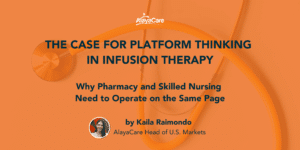Published in Specialty Pharmacy Continuum | August 25, 2021 | Written by Karen Blum
The time is ripe for ambulatory infusion centers (AICs) to gain a stronger foothold in U.S. health care, a panel of experts said during the MHA 2021 Business Summit, held virtually.
“There’s a lot of tailwinds in this industry,” said Reece Norris, JD, a co-founder and the CEO of WeInfuse, an infusion software, and consulting company. Payors and health plans are looking for sites of care (SOC) for infusion therapies that are more cost-effective than hospitals without compromising care, Mr. Norris said. With many autoimmune biologic specialty drugs having a limited distribution, the logistics of getting this in the home can be so burdensome that “it makes sense” to administer them in AICs, he noted.
“We are seeing payors push patients out of the hospital into more cost-effective sites of care,” Mr. Norris said. “We see this space continuing to expand, especially as the formulary of drugs gets larger.”
The SOC optimization trend has been building for several years, said Logan Davis, PharmD, MBA, the director of franchise development for Vital Care Infusion Services, in Meridian, Miss. The COVID-19 pandemic further demonstrated to the industry that being dependent on hospital-based infusion centers isn’t ideal, he said.
“There just isn’t enough capacity in the country at the moment” for stand-alone infusion centers, added Bryan Johnson, a co-founder and the CEO of WeInfuse, echoing the push by insurers to administer infused medications outside the hospital setting. “Wherever we can get a chair, an IV pole and a nurse, let’s try to make that site accessible to a patient, whether that’s in a home or through a management company. You’ll continue to see that—there’s just a lot of pressure coming down from the top.”
Adding to the market opportunity for expansion is a robust pipeline of specialty infusion drugs, including aducanumab (Aduhelm, Biogen), approved in June for the treatment of Alzheimer’s disease (see page 20 for more coverage), and several others still in trials for Parkinson’s disease, the panelists said. The boundaries are blurring among specialties, medications, and diseases, Mr. Johnson noted. For example, infliximab (Remicade, Janssen) is being used for both gastrointestinal and rheumatic conditions. Medical specialists accustomed to having few infusion medications available aren’t likely to have office-based infusion suites, he added, and as specialty infusion medications cross into more common diseases covering more people, the demand for services will continue to rise.
Payors are reaching out to urgent care center chains, home infusion pharmacies, and other regional service providers to open capacity to treat specialty medication patients in AICs, Mr. Norris said. In addition, some home infusion pharmacies are building infusion suites to capture the medical benefit market they could not traditionally access through the pharmacy benefit. Some home infusion pharmacies are adding infusion management services to their list of offerings. The infusion space is experiencing significant investment from both private equity and industry, Mr. Johnson added.
Why Launch?
There are numerous reasons to launch an infusion clinic, Dr. Davis said. Some of his franchisees wanted to be able to accept more referrals in their markets, access Medicare Part B benefits for referred patients, access drugs and better pricing limited to the infusion clinic class of trade, and access commercial payor contracts available to infusion clinics. But a sharp marketing and sales strategy is critical to success when starting out, the panelists said.
“This is not a ‘build it and they will come’ space,” Mr. Norris said. “You can have the best nurses, the nicest building, and the finest equipment, but you have to earn the trust in the community from referring providers.” This can involve the hard work of cold calling, creating medication-specific order forms to ease work for referring physicians, and treating referrals as gold. Communicate back to referring physicians how the infusion went, he advised, even if it’s just a quick treatment note.
When thinking about the physical space and build-out, most operators focus on factors such as infection control and meeting codes. But it’s equally important to consider patient amenities such as great parking, expanded hours, free Wi-Fi, and coffee, Mr. Johnson said.
“Think more Starbucks and less stainless steel,” he said. “These patients have chronic conditions they will visit you with every few weeks, maybe for the rest of their lives. They want to be comfortable. You want them to look forward to coming to your facility.”
Mr. Johnson suggested these additional operational strategies:
- Consult resources such as the National Infusion Center Association or the Infusion Nurses Society to note best practices and standards.
- Hire a licensed professional (e.g., a physician, physician assistant, or nurse practitioner) for clinical leadership. Their expertise will be needed in updating and maintaining protocols as well as dealing with any adverse events and communicating with other health care professionals.
- Write and review emergency protocols, and post them clearly for your clinical team.
Not All Centers Created Equal
Although the infusion itself is the same whether it’s administered in a hospital or another setting, AICs are different in terms of their regulation, reimbursements, and class of trade, commented David Franklin, the president of Advanced Care Consulting Services, in Ray, Mich.
“There’s a really interesting new hybrid where independent infusion centers are partnering with physicians,” he said, “where physicians hold stock in the company, but they partner with independent infusion centers to operate the services through management contracts. That’s what’s going on now more than anything.”
Still, some of these independent infusion centers are facing reimbursement challenges because they may not be recognized by Medicare and Medicaid, Mr. Franklin noted.




